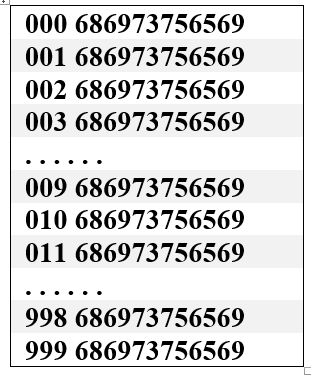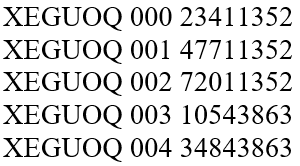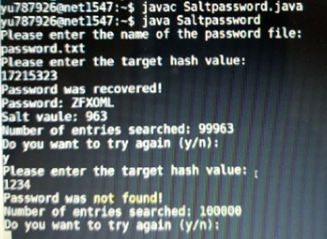Question
Please generate code in C++ or JAVA. Also, show a snapshot of results. I have included a snipit of what results SHOULD look like. Please
Please generate code in C++ or JAVA. Also, show a snapshot of results.
I have included a snipit of what results SHOULD look like. Please DO NOT post a snipit of code.
Instructions below.
Since normally passwords are stored as hash values, the common way to conduct a dictionary attack is to hash every password in the password file and store the hash value. Whenever we obtain a hash value, we can compare this value against the hash values in the file. If we find a match, we would know which password the hash value corresponds to. Then the password is recovered. In our case, for a file with only 100 passwords, only 100 hash values would be generated. It is very easy to search 100 hash values. To increase the difficulty of dictionary attack, password salt is introduced. The salt is a random value that we attach to a plaintext password. The hash value is calculated on the salted password (i.e. H(salt | password)). The salt (i.e. the random value) adds the uncertainty to the password. For each password, the number of possible hash values is equivalent to the number of possible combinations of salt.
In this assignment, you will use a three-digit salt. This means the salt is a decimal number and each digit can be one of 10 possible numbers, namely 0-9. Since a salt has three digits, the number of all possible salt values is 10x10x10=1000. For one password, there are 1000 possible hash values. For a file of 100 passwords, the total hash values are 100x1000=100,000. In other words, the search space for the dictionary attack is 100,000. One way to conduct the dictionary attack for the salted password is to attach every possible salt to a password and then hash the salted password (i.e. password with salt attached). Then we store all the hash values in a dictionary file. When we obtain a hash value for an unknown password, we search this value in the dictionary file. If we find a match, then the password is recovered (since the dictionary file should list which password the hash value corresponds to). With the salt, the size of the dictionary file increases 1000 times in this example.
As mentioned above, each password has 6 uppercase letters. To calculate hash, those letters would be converted to numeric values. Here we use ASCII value to represent a letter. ASCII values are widely used in computer to store character. The ASCII table can be found at https://www.asciitable.com/ (Links to an external site.)Links to an external site.. The uppercase letters have values ranging from 65 to 90. If a password is DEIKAE, you would first lay out the ASCII value of every letter side by side. So for the password of DEIKAE, you would generate 686973756569. Then you would insert the salt in front of this number sequence. For example, if a salt is 109, you would generate 109686973756569. Then apply the following hash function to this number sequence
Hash function = ( ( 243 x left ) + right ) % 85767489
Where, left is the left 8 digits of the number sequence. In this example, it is 10968697, which is treated as a long integer number. And right is the rest 7 digits of the number sequence. In this example. it is 3756569, which is treated as a long integer number.
The result of the hash function is the hash value for this salted password. If we want to generate all possible hash values for this password, we need attach all possible values of salt to the password one by one. For the password DEIKAE (whose ASCII string is 686973756569). We should have 1000 salted password possibilities for this password as shown below. Then the hash values for those 1000 salted passwords will be stored in the dictionary file.

2. Implementation
2.1 Inputs
As mentioned above, we will provide a password file, which contains 100 passwords. Your program will ask the user to enter the name of the password file. For the user input, you can use scanf (in C programming) or Scanner class (in Java) or anything equivalent. Then the program will ask the user to enter a hash value. Your program will try to recover the password based on this hash value. Note this value should be treated as long integer.
2.2 Dictionary File
Based on the input password file, you will generate a dictionary file which contains all possible hash values for all password. As mentioned above, for each password the possible hash values are 1000. Therefore, the dictionary file will have 100 x 1000 = 100,000 entries. Your program will save all entries in a text file. You are required to generate this text file. The entries of this dictionary file has the following format: [password salt hash_value]. For example, the first few entries of dictionary file should be similar to the following:

2.3 Outputs
Once the user enters the name of password file, your program can generate the dictionary file as described above. Now given a hash value, you can recover password by matching the given hash value to one of the hash values in the dictionary file. You will ask the user to enter a hash value as the target hash value. Then you program searches the dictionary file for this value. If a match was found, your program should print out indication that the password is recovered. Then the program should print out the recovered password (which is the password corresponds to the hash value) and the number of entries has been searched. If the user-entered hash value does not match any hash value in the dictionary file. You should also print out a line indicating the password is not found and number of entries has been searched. In this case, the number of entries searched should be 100,000.
2.4 Long Integer
Since this assignment involves concatenating numbers, some of the numbers are too big to be stored in int. When your program calculates hash function or prompt the user to enter hash value, please remember using long to store the values.
2.5 Procedure
The basic procedure and requirements for this assignment are listed below:
Step 1: Prompt the user to enter the name of password file
Step 2: Generate the dictionary file
Create a dictionary file and for each password
Step 2.1: Generate all possible 3-digit salt
Step 2.2: Attach each salt to the password
Step 2.3: Calculate hash value using the hash function
Step 2.4: Write password, salt and hash value to the file
Step 2.5: Repeat Step 2.2-2.4 for all salts
Step 2.6: Repeat Step 2.1-2.5 for all passwords
Step 3: Prompt the user to enter a hash value.
Step 4: Search the dictionary file for a match of this value. If a match is found, print out a success message and show the recovered password, salt value and number of entries have been searched. If no match is found, print out a failure message and show the number of entries haven been searched.

Step by Step Solution
There are 3 Steps involved in it
Step: 1

Get Instant Access to Expert-Tailored Solutions
See step-by-step solutions with expert insights and AI powered tools for academic success
Step: 2

Step: 3

Ace Your Homework with AI
Get the answers you need in no time with our AI-driven, step-by-step assistance
Get Started


